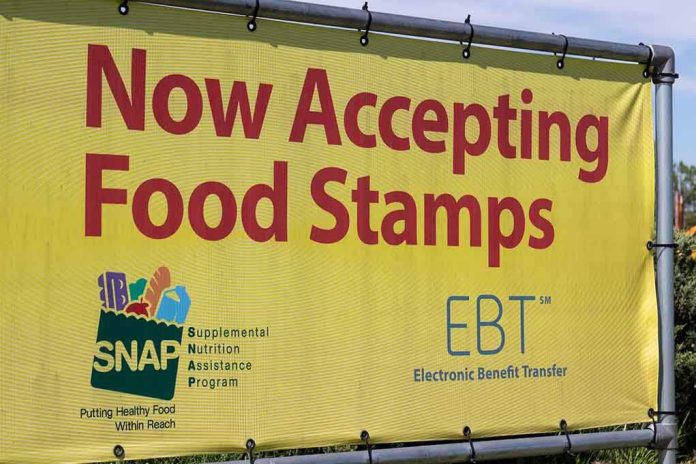
When the government pulls the plug on SNAP benefits overnight, 42 million American dinner tables go bare—and suddenly, political gamesmanship isn’t just an inside-the-Beltway blood sport, it’s a kitchen-table crisis.
Story Snapshot
- USDA confirms no federal SNAP benefits will be delivered for November 2025, citing a government shutdown and depleted funds.
- State agencies are ordered to halt November benefit issuances, leaving millions—including children and seniors—without food assistance.
- USDA and some lawmakers publicly blame Senate Democrats for not passing a budget, igniting fierce partisan blame.
- States scramble for emergency measures, but no solution can match the scale of SNAP’s reach.
SNAP Benefits Suspended: A Political Standoff That Hits America Where It Hurts
The U.S. Department of Agriculture’s announcement that November 2025 SNAP benefits will not be distributed marks a line not crossed in recent memory. SNAP, the country’s largest nutrition assistance program, serves as a lifeline for more than 42 million Americans. When USDA officials notified state agencies like South Carolina’s Department of Social Services to freeze November benefit files, it transformed a Capitol Hill budget brawl into a full-blown national emergency. The abrupt cutoff is not just a bureaucratic hiccup; it is a shockwave reaching deep into every state, every city, every small town struggling to keep food on the table.
"USDA announces no federal SNAP benefits will be delivered over government shutdown, blames Democrats" – New York Post #SmartNews own it @DNC https://t.co/GNkvvpdsH8
— justice seeking the truth (@realpeggyyoung) October 27, 2025
The timeline leading to this crisis reads like a slow-motion train wreck. Early October 2025: Congress fails to pass a federal budget, triggering a government shutdown. October 1: The USDA assures recipients that October SNAP benefits will be paid with remaining funds. By October 10, the agency’s tone shifts—states are told to hold November benefit files, a warning that the funding well is dry. The situation escalates on October 22, when states like South Carolina and New Mexico start alerting the public: if Washington stays closed, November food assistance vanishes for hundreds of thousands of households. Come November 1, unless Congress acts, those benefits are officially suspended.
Finger-Pointing in Washington as Dinner Plates Go Empty
The sense of urgency in state capitals contrasts sharply with the blame game on Capitol Hill. The USDA and several political figures have pinned the crisis on Senate Democrats, accusing them of blocking the budget measures that would keep SNAP funded. Republican leaders echo this message, framing the shutdown as a direct result of Democratic inaction. Meanwhile, Democrats counter that Republicans have loaded spending bills with poison pills and are using SNAP recipients as bargaining chips for unrelated policy demands. The result is a standoff where each side accuses the other of cruelty, while neither side produces a solution that puts food back on the table.
Governors and state agencies, left to manage the fallout, have little room to maneuver. New Mexico’s governor, for example, announced emergency food bank funding but admitted state resources cannot even begin to replace the scale of SNAP’s support. Advocacy groups and food pantries nationwide brace for an unprecedented surge in need, already warning that their shelves will empty long before the hunger does. The immediate shock will hit America’s most vulnerable: children, seniors, people with disabilities—those least able to weather a gap in their basic nutrition.
A Systemic Weakness Exposed: The Limits of State and Charity Responses
No state budget, no matter how robust, is designed to backfill a federal program of SNAP’s magnitude. States like South Carolina and New Mexico are activating every emergency lever, but even the most ambitious local efforts are dwarfed by the scale of lost federal benefits. Food banks and nonprofits, already stretched thin by post-pandemic demand, warn that they cannot fill the gap. Retailers in low-income neighborhoods brace for sharp drops in business, knowing that SNAP dollars are often the difference between profit and closure. Healthcare professionals raise alarms about malnutrition and cascading health effects that will hit hospitals and clinics in coming months.
The economic impact will ripple outward, from lost grocery sales to increased pressure on public health systems. But the social and political effects may run even deeper. The suspension of SNAP benefits, unprecedented at this scale, raises unnerving questions about the reliability of America’s safety net. Trust in federal programs—already battered by years of dysfunction—may erode further. Some policy experts warn that, unless Congress reforms how SNAP is funded, future shutdowns could make this kind of crisis routine.
Expert Voices Warn of a Tipping Point
Nutrition experts and social policy scholars are nearly unanimous: this is not just another partisan squabble, but a test of the social contract itself. SNAP, once considered untouchable in budget negotiations, is now a pawn in high-stakes political warfare. The public blame placed on Senate Democrats by the USDA and others is rare and reflects just how toxic the budget process has become. While Congress debates, families wait—and hunger grows more acute with each passing day. The call from experts and advocates is clear: without a sustainable solution, the cycle will repeat, and the damage to public trust and American communities may be lasting.
The crisis exposes the reality that, for millions of Americans, government dysfunction is not an abstraction—it is a matter of daily survival. Until Congress acts, the question is not who wins the blame game, but how many Americans lose their next meal.
Sources:
South Carolina Department of Social Services: SNAP Impact Alert
New Mexico Governor Responds to USDA SNAP Suspension
Economic Times: SNAP Payments Halted















